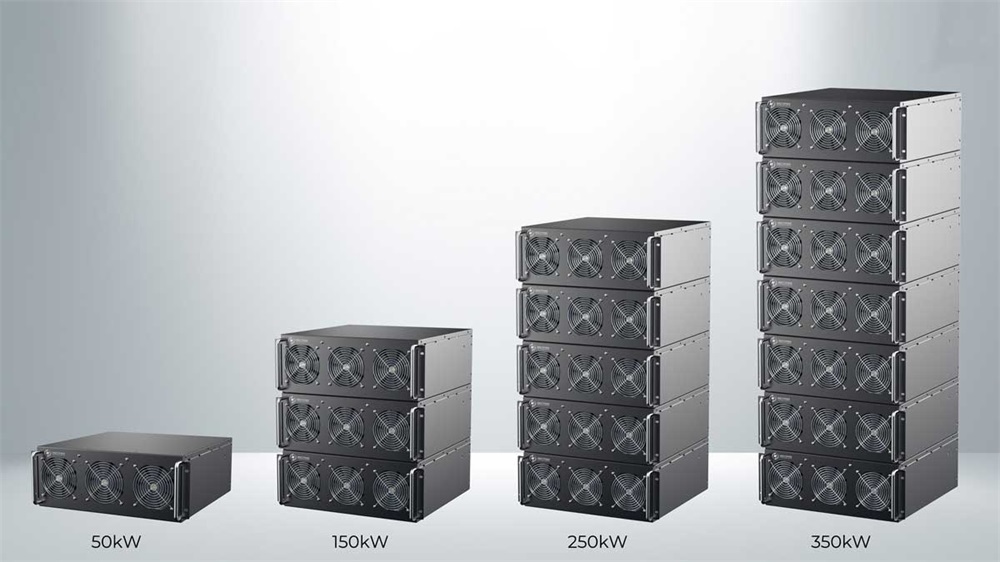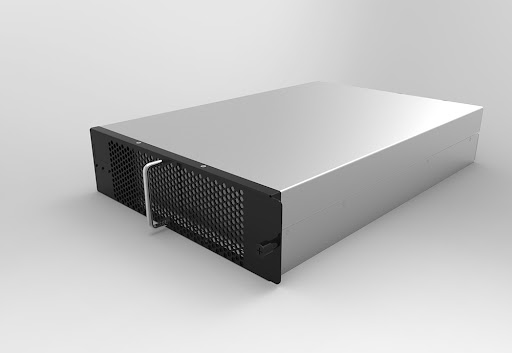Charging modules are the core components of direct current (DC) charging piles for electric vehicles (EVs). As the adoption rate and ownership of new energy vehicles (NEVs) in China continue to rise, the demand for charging piles is also increasing. EV charging is divided into alternating current (AC) slow charging and direct current (DC) fast charging. DC fast charging is characterized by high voltage, large power, and rapid charging. As the market seeks higher charging efficiency, the market size for DC fast charging piles and charging modules is expanding continuously.
The electric vehicle charging module industry currently features characteristics such as high power single modules, high frequency, miniaturization, high conversion efficiency, and a wide voltage range.

Regarding single-module power, the industry has progressed from 7.5 kW in 2014, to 15 kW in 2015, and to 25 kW in 2016. Currently, the main products are 20 kW and 30 kW. Solutions for 40 kW charging modules have emerged, indicating a trend towards higher power modules in the future.
In terms of output voltage, the 2017 edition of the National Grid's "Qualification and Capability Verification Standards for Electric Vehicle Charging Equipment Suppliers" states that DC chargers should have an output voltage range of 200-750V, covering at least 400-500V and 600-750V for constant power. Thus, most module manufacturers design modules to cover 200-750V. With the increase in EV range and the demand for shorter charging times, 800V super-fast charging architectures have been proposed, with some companies supplying modules that cover a wide voltage range of 200-1000V.
For high frequency and miniaturization, while the power of single-module charging piles has increased, their size has not scaled proportionally. Therefore, increasing switching frequency and integrating magnetic components are key methods to enhance power density.
In terms of efficiency, major companies in the charging module industry currently achieve peak efficiencies of 95%-96%. With the development of third-generation power devices and the proliferation of 800V or higher voltage platforms for electric vehicles, the industry is expected to see products with peak efficiencies exceeding 98%.
As the power density of charging modules increases, so does the heat dissipation challenge. The main cooling methods in the industry include forced air cooling, enclosed air channels, and water cooling. While air cooling is cost-effective and simple, its limitations become more apparent with increasing heat dissipation requirements, such as limited cooling capacity and high noise. Consequently, liquid cooling solutions for modules and connectors are becoming a primary technical direction.
In recent years, technological advancements in the new energy sector have accelerated the development and penetration of the upstream charging module industry. The significant increase in battery energy density has addressed the issue of limited range in NEVs, and the application of high-power charging modules has greatly reduced charging time. This has accelerated the popularization of NEVs and the construction of supporting charging piles. Looking ahead, the integration of technologies like photovoltaic storage and charging, and vehicle-to-grid (V2G) systems, is expected to further accelerate the penetration and consumption of the new energy industry.
Charging modules are the core components of direct current (DC) charging piles. With the global rise in the adoption of new energy vehicles (NEVs), consumers are increasingly concerned about charging range and convenience. The demand for DC fast charging piles has surged, and the domestic charging pile market, which initially relied heavily on the State Grid, has diversified. A number of social capital operators with both charging pile equipment manufacturing and operational capabilities have rapidly emerged. Domestic charging module manufacturers are expanding their production and sales scale to support the growth of charging pile infrastructure, enhancing their comprehensive competitiveness.
Currently, after years of product iteration and development, competition in the charging module industry is intense. Mainstream products are evolving towards higher voltage and higher power density, with significant market space. Industry players mainly compete by continuously improving product topology, control algorithms, hardware, and production systems to gain higher market share and profitability.
As the demand for charging modules grows, technology is advancing towards higher power density, wider voltage ranges, and higher conversion efficiency.
1. Shift from Policy-Driven to Demand-Driven
Initially, government policies primarily guided the development of charging infrastructure to support the growth of NEVs. Since 2021, the rapid development of NEVs has created a huge demand for supporting infrastructure and charging piles. The charging pile industry is transitioning from policy-driven to demand-driven development.
With the increasing number of NEVs, there is a need not only to increase the density of charging pile deployment but also to further reduce charging times. DC fast charging piles, which offer faster charging speeds and shorter charging times, are particularly suited for users' urgent and temporary charging needs. This addresses concerns about vehicle range and charging anxiety. As a result, the market for DC fast charging piles, especially public ones, has rapidly grown and become a mainstream trend in many core cities in China.

In summary, with the continuous growth in NEV ownership, there is an ongoing need to improve charging infrastructure. Meanwhile, NEV users are increasingly seeking DC fast charging. DC charging piles have become mainstream, and charging modules are in high demand, entering a stage of development driven primarily by market demand.
2. High Power Density, Wide Voltage Range, and High Conversion Efficiency
Fast charging requires high charging power. To meet the growing demand, charging modules are evolving towards higher power levels. High power in charging piles is achieved through either paralleling multiple modules for power addition or increasing the single-module power. Improving the power of individual charging modules is a long-term trend to meet the technical demands for higher power density, smaller size, and reduced electrical complexity. Charging modules in China have evolved through three generations, from 7.5 kW in the first generation to 15/20 kW in the second generation, and now transitioning to 30/40 kW in the third generation. High-power charging modules are becoming mainstream.
There are two ways to achieve higher power levels in DC fast charging: increasing voltage or current. Tesla initially adopted high-current charging solutions, which optimize component costs but present high heat loss and cooling challenges, limiting convenience. High-voltage solutions, which increase the maximum operating voltage of charging modules, are commonly used by car manufacturers. These solutions reduce energy consumption, improve battery life, and save space. Currently, most fast-charging solutions use 400V high-voltage platforms, and with the development of 800V platforms, the voltage level of charging modules will further increase.
Improving conversion efficiency is a constant goal for charging modules. Higher efficiency means better charging performance and lower losses. Current peak efficiencies for charging modules are around 95%-96%, but with advancements in third-generation power devices and higher voltage platforms, efficiency is expected to rise further.
3. Enhancing the Value of Electric Vehicle Charging Modules
Charging modules are the core components of DC charging piles, accounting for about 50% of the hardware cost. Future improvements in charging efficiency will largely depend on enhancing charging module performance. Increasing the number of parallel modules directly boosts their value, while enhancing single-module power levels and density depends on hardware circuit and control software optimization and breakthroughs in key components. These are critical technologies for increasing the overall power of charging piles and will further enhance the value of charging modules.
Power technology is an interdisciplinary field integrating circuit topology, digital technology, magnetic technology, component technology, semiconductor technology, and thermal design. It is a technology-intensive industry. As the heart of DC charging piles, charging modules directly impact charging efficiency, operational stability, and reliability, highlighting their importance and value. Developing a product from research to application requires substantial resources and specialized talent. Choosing electronic components, optimizing software algorithms, accurately understanding application scenarios, and having robust quality control and testing capabilities all directly affect product quality and stability. New entrants face significant technological barriers due to the high difficulty in quickly accumulating the necessary technology, personnel, and application data.
Next:How to charge 48V lithium ion battery? How to charge 48V lithium battery initially?
Previous:How to Choose the Right Charger for LiFePO4 Batteries?
Contact Person: Miss. Kiki
| WhatsApp : | +8617763224709 |
|---|---|
| Skype : | +8617763224709 |
| WeChat : | +8617763224709 |
| Email : | kiki@lifepo4-battery.com |